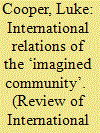| Srl | Item |
| 1 |
ID:
144566


|
|
|
|
|
| Summary/Abstract |
Employing national identity theories and survey data in Taiwan, this article explains national identity shift in Taiwan. Descriptively we find that most Taiwanese people reject being called ‘Chinese’ (zhongguoren) when asked about their national identity. However, they do not deny their ethnic and cultural Chinese identity. What they object to is being called Chinese nationals, especially this China which is internationally recognized as the People’s Republic of China. In other words, most Taiwanese people do not identify themselves with the mainland Chinese state even though they still associate themselves with the Chinese nation. It is also noted that there is no consensus with regard to national identity in Taiwan, since close to one third of the population still do not object to be called zhongguoren. The author’s analytical findings further confirm that external sovereignty-related factors are related to the Taiwanese national identity shift. Specifically, a changed state boundary, separation desire from mainland China, and recognition of Taiwan as a sovereign state, not the distinctive cultural reconstruction inside Taiwan, contribute to the national identity shift in Taiwan.
|
|
|
|
|
|
|
|
|
|
|
|
|
|
|
|
| 2 |
ID:
139587


|
|
|
|
|
| Summary/Abstract |
Benedict Anderson's Imagined Communities has long been established as one of the major contributions to theories of nations and nationalism. Anderson located the rise of national identities within a long-evolving crisis of dynastic conceptions of identity, time, and space, and argued print-capitalism was the key cultural and economic force in the genesis of nations. This article offers a critical appropriation and application of Anderson's theory through two steps. Firstly, it evaluates the conceptual underpinning of his approach through an engagement with recent scholarship on the ‘theory of uneven and combined development’. The fruits of this interchange provide a deeper analytical framework to account for what Anderson calls the ‘modularity’ of national identity, that is, its universal spread across the globe. Modularity is now reconceptualised as a product of combined development with its causal efficacy derived from the latent dynamics of a geopolitically fragmented world. The latter gave shape and form to the new national communities. Secondly, this revised framework is applied to the emergence of Chinese national identity in the late nineteenth century. This allows Chinese nationalism to be recast as an ideological amalgam of indigenous and imported elements that emerged out of the crisis-ridden encounter between Imperial China and Western imperialism in the nineteenth century.
|
|
|
|
|
|
|
|
|
|
|
|
|
|
|
|
| 3 |
ID:
179166


|
|
|
|
|
| Summary/Abstract |
This article examines a paradigm shift in the PRC that has occurred over the past two decades which has transformed the meaning of “minority nationality” (shaoshu minzu). Today, the very concept of minority nationalities is perceived by Beijing as entailing a threat to the Chinese state and the Chinese nation. The shift underlies a change of China’s institutional form from a “multinational state” to a “unified community of the Chinese nation.” The result is the current heavy-handed approach toward China’s minority peoples, especially in borderlands such as Xinjiang, Tibet, and Inner Mongolia. The article suggests that these minority nationalities are now understood by the Chinese leadership to constitute veritable Frankenstein’s monsters that were created by the Party’s minority-nationality classification system and have now grown strong enough to attack their creator.
|
|
|
|
|
|
|
|
|
|
|
|
|
|
|
|